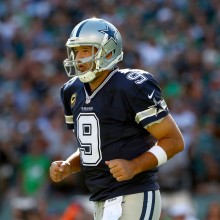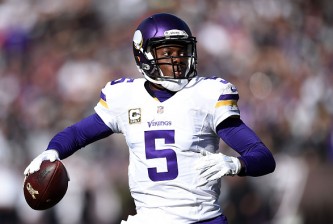
The Minnesota Vikings surprised most people by taking Christian Ponder with the twelfth pick in the 2011 NFL draft. Ponder wasn’t supposed to be the quarterback of the present, with Donovan McNabb in the fold. McNabb proved ineffective, though, and Ponder ended up starting ten games as a rookie. The results from that playing time were, well, not good. A number of Ponder’s mistakes were of the rookie variety and he can cure them himself.
To really improve, though, the Vikings’ offense around him needs to improve. Can it in 2012, especially with Adrian Peterson unlikely to be at full strength for at least the start of the year after a horrific knee injury?
Every quarterback’s best friend is a good offensive line. If that’s the case, Ponder was all alone without a friend in the world in 2011. He attempted 291 passes and was sacked nearly thirty times. That’s roughly once in every eleven dropbacks. And it wasn’t just Ponder who was sacked, as McNabb and Webb also went down at high rates. The Vikings simply have to improve their offensive line.
Fortunately, there’s one logical solution: the Vikings have the third pick in April’s NFL draft, and there are two highly-regarded quarterbacks who will almost certainly be chosen first and second overall. That leaves the Vikings with an easy choice of USC left tackle Matt Kalil. Kalil, the younger brother of Panthers’ center Ryan, had been a rock for the Trojans the past couple years, and is in Jake Long’s class as a prospect.
How good is Kalil? The Cowboys recently announced they’re moving Kalil’s former teammate Tyron Smith, last year’s ninth overall pick, to left tackle. Smith would have played left tackle at USC as well, but Kalil was better, forcing Smith to move to right tackle to get on the field.
Kalil isn’t a man-mountain like former left tackle Byron McKinnie, but teams won’t find it as easy to turn the corner and is reportedly a solid citizen. He’s not a perfect prospect, and probably needs to add some strength to avoid being bulled by NFL defensive linemen. Still, he’d be an easy choice for the first overall pick in any year without a surefire franchise quarterback.
Adding Kalil will also let the Vikings move Charlie Johnson to his more natural guard position. The former Colt was forced into the starting lineup with McKinnie’s release and simply isn’t an NFL-caliber left tackle. Johnson will probably only slot over one spot, as age and health have taken their toll on former All-Pro Steve Hutchinson. Due $7 million in 2012, Hutchinson is unlikelly to return. Also unlikely to return is the other starting guard, Anthony Herrera, who’s not very good. The Vikings are probably hoping last year’s sixth-round pick Brandon Fusco can win the starting job.
The other two line spots should be relatively stable. Center John Sullivan inked a five-year extension in 2011. He’s not one of the league’s best centers, but is more of a strength than a weakness. Phil Loadholt doesn’t face any serious challengers at right tackle. A man-mountain in the mold of McKinnie, he’s best as a drive-blocker but can be shakier in pass protection, especially against speed rushers, and is vulnerable to getting grabby.
Running back is, of course, a strength with Peterson, and Toby Gerhart is a capable backup. At tight end, Visanthe Shiancoe is an unrestricted free agent and may look for another team more likely to win games and where it’s more likely he’ll be the unquestioned top tight end. Rookie Kyle Rudolph showed flashes of promise, and the Vikings are hoping he and Ponder will grow together.
Beyond offensive line, though, the Vikings need to build and strengthen the wide receiver position for Ponder to improve. Percy Harvin played all 16 games and had probably a better season than you think he did. Michael Jenkins played opposite him. While he’s a willing blocker, he displayed the kind of receiving (in)ability that showed why the Falcons were eager to trade up for Julio Jones. Quality depth behind them is basically nil, as Bernard Berrian was released during the season and, well, Devin Aromashodu and Greg Camarillo are Devin Aromashodu and Greg Camarillo.
With Kalil a virtual lock at third overall, the Vikings should probably look to the free agency class first for a starting-caliber wide receiver. The Vincent Jackson rumors of the past were apparently closely tied to former coach Brad Childress; with Childress gone, he’s likely not at the top of the list. With a need to rebuild the secondary as well and Harvin the number one, the Vikings are probably more likely to pursue a second-tier starting wide receiver like Mario Manningham. A relatively high draft pick is also a strong possibility, even if a starter is added in free agency. A player with return ability, so Harvin can focus on offense (and avoid injuries), would be a nice bonus.
Will these changes be enough to help Ponder? Obviously it depends on who exactly is added to the wide receiver corps. A good starter and a rookie who makes an immediate impact could do great things, while more of Jenkins as a starter and a rookie with more rookie downs than ups could leave the situation mostly unchanged. The offensive line is capable of being average or better strictly from internal improvements, at least theoretically. Loadholt’s development is the X-factor. A rapid return to full health by Adrian Peterson would clearly do great things in limiting just how much Ponder has to do on his own.
The most important thing will be Ponder’s personal improvement. With an offseason where he can talk to coaches and a year of film of his own play to look at, he can improve his technique, knowledge of the playbook, and defensive recognitiion. if that happens, the Vikings could have at least an average passing offense. And compared to where they were last season, that would be big improvement. The Vikings are unlikely to end up at the top of a tough NFC North, but a rapid return to respectability is not out of the question.
{loadposition content1}






















